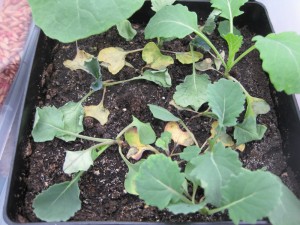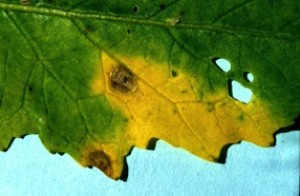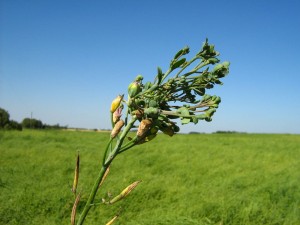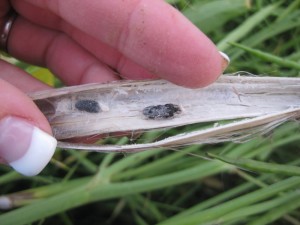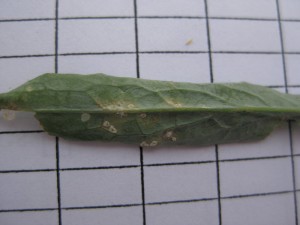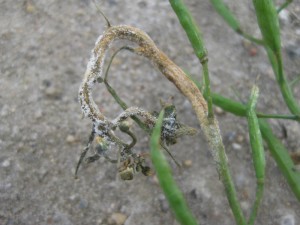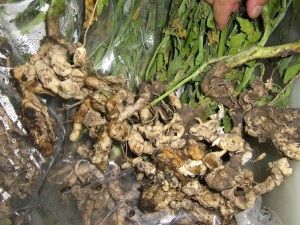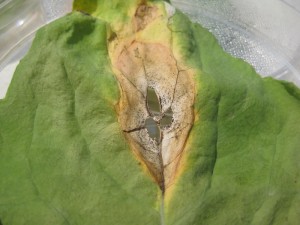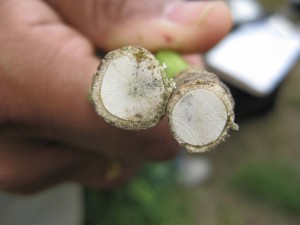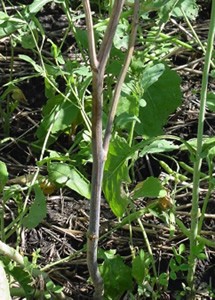The Brassicaceae family (formerly Cruciferaceae family) includes various Brassica species, representing oilseed, vegetable and fodder crops. Brown mustard and oriental mustard (Brassica juncea) are members of this genus. In the same family but a different genus are yellow mustard (Sinapis alba) and wild mustard (Sinapis arvensis). Because of their close relationship, plants in this family are often susceptible to the same diseases. The following is an outline of diseases of crucifers with comments on the potential for disease in mustard (Sinapis alba and/or Brassica juncea).
Damping-off, Wirestem, and Brown Girdling Root Rot
Pathogen(s): Damping off – Phytophthora cactorum and/or Pythium spp. Wirestem and brown girdling root rot – Rhizoctonia solani
Host range: Seedling diseases including damping-off, seedling blight, wirestem, and root rot affect Brassica and other plant species including pulses and flax.
Risk: High
Symptoms: Watch for seeds that fail to germinate or fail to emerge, and roots that turn brown or seedlings that turn yellow, shrivel and decay, particularly at the stem base.
Alternaria Diseases (Black spot, Gray Leaf Spot, Pod Spot)
Pathogens: Alternaria brassicae and/or Alternaria brassicola
Host Range: Most of the economically important vegetable, oilseed, forage, and condiment brassicas, and many wild and weedy crucifers.
Risk: High
Symptoms: Watch for gray to purple to black small spots or lesions that may expand into concentric zones surrounded by a yellow halo.
Aster Yellows
Pathogen: Aster Yellows Phytoplasma
Host Ranges: Most of the economically important vegetable, oilseed, forage, and condiment brassicas, and many wild and weedy crucifers.
Risk: High
Symptoms: Watch for blue-green discoloured plants, with leaves developing a red or purple tinge. Malformed flowers and may produce sterile, green leaf-like structures, and pods are replaced by round or oval blue-green hollow, flattened bladder-like structures. Infected plants may become woody and are often taller than the rest of the crop canopy.
Sclerotinia White Mould
Pathogen: Sclerotinia sclerotiorum
Host Range: Extremely wide host range among dicots, including crucifers, and other important broadleaf crops and weeds.
Risk: High
Symptoms: Watch for soft, water-soaked white to gray lesions on leaves and stems. Plant parts above the affected area may turn pale green or yellow, wilt and die. Mature lesions will become bleached shred easily, resulting in premature ripening and lodging. White mould may grow on rotting stems and sclerotia may be evident inside infected stems.
Downy Mildew
Pathogen: Hyaloperonospora parasitica
Host Range: Common on cabbage, Brussels sprouts, cauliflower, broccoli, kale, and kohlrabi; Chinese cabbage, turnip, and turnip rape; oilseed rape and rutabaga; brown mustard and oriental mustard; black mustard and Abyssinian mustard. Many other crucifers including yellow mustard and wild mustard area also likely hosts.
Risk: Medium
Symptoms: Watch for a mealy growth on the underside of the leaf, corresponding to yellowing of the upper surface of the leaf.
White Rust
Pathogen: Albugo candida
Host Range: Common on B. oleracea, B. rapa, B. juncea (brown mustard and oriental mustard), B. nigra (black mustard), and B. carinata (Abyssinian mustard). Radish, horseradish, wild mustard, shepherd’s purse, and other weedy species are also likely to be infected.
Risk: Medium
Symptoms: Watch for white pustules and “staghead” deformation of flowering stems and pods.
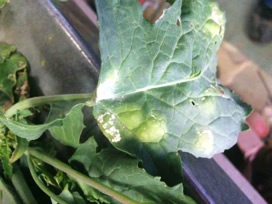
White rust symptoms on the upper surface of an infected brown mustard leaf (Photo by Lawrence Barany)
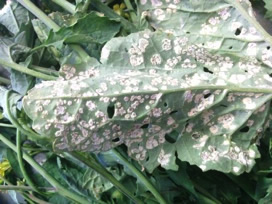
Powdery white pustules on the lower surface of a brown mustard leaf infected by Albugo candida (Photo by Lawrence Barany)
White Leaf Spot and Gray Stem
Pathogen:Mycosphaerella capsellae
Host Range: Wide range of crucifers, including canola, mustards and a variety of cruciferous weeds.
Risk: Medium
Symptoms: Watch for white to gray leaf spots that may spread to give an overall gray appearance to plants.
Clubroot
Pathogen: Plasmodiophora brassicae
Host Range: Cruciferous field crops such as canola, mustard (all types), camelina, oilseed radish and taramira; as well as cruciferous weeds (e.g. stinkweed, shepherd’s purse, wild mustard) and vegetables.
Risk: Medium (risk increases when mustard is grown in known clubroot infested areas and environmental conditions favour clubroot disease development)
Symptoms: Watch for suspicious stunting, wilting, yellowing and premature ripening. Check the roots for clubroot galls.
More information about clubroot can be found here.
Blackleg
Pathogen: Phoma lingam, Leptosphaeria maculans and/or Leptosphaeria biglobosa
Host Range: Economically important on a variety of brassica crops, but those with the B genome, including B. juncea, B. carinata, and B. nigra are more resistant than other Brassica species. Can occur on Sinapis spp.
Risk: Low – Risk can increase when the plant is wounded
Symptoms: Watch for round to irregularly shaped dirty white lesions on the leaves and white or gray lesions with a dark border on stems or points of leaf attachment. Stem lesions may also appear as a general blackening or dry rot inside the stem base. Blackleg lesions are usually dotted with numerous tiny round specks (pycnidia).
Fusarium Wilt
Pathogen:Fusarium oxysporum and/or Fusarium avenaceum
Host Range: Cabbage is the most significant host crop, but also infects other brassica crops including canola and mustards.
Risk: Low
Symptoms: Watch for wilting, stunting, and yellowing, with yellow or red discolouration at the stem base, and development of symptoms on only one side of stems.
Verticilium Wilt
Pathogen: Verticillium longisporum
Host Range: Severe symptoms in oilseed rape and certain other Brassica species, and wild mustard. No information on yellow and brown mustard. Non-cruciferous hosts may also be infected but economic damage not reported.
Risk: Low
Symptoms: Watch for wilting, stunting, and yellowing, with yellow or red discolouration at the stem base, and development of symptoms on only one side of stems, in addition to shredding of the epidermis containing tiny black microsclerotia.
< Previous: Pest Control: Insects: Pests at flowering and podding stages
